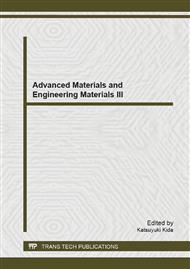[1]
Kong QinHua, Yu YunHe. The experimental study of machining residual stress, Journal of Tongji University, 1999, 27(5):P. 449-552(In Chinese).
Google Scholar
[2]
Cai ZaiQin. Principles of metal cutting[M]. Tongji University press, 1994 (In Chinese).
Google Scholar
[3]
Guo Peiyan. Analysis and simulation speed machining surface residual stress[D]. Shandong: Shandong University of Science and Technology, 2007 (In Chinese).
Google Scholar
[4]
Lan Jianshe. Mechanical manufacturing process and fixture[M]. Beijing: Machinery Industry Press. 2004 (In Chinese).
Google Scholar
[5]
Liu Haitao, Lu Zesheng, Sun Yazhou. Residual machining surface should be the status quo and Development Research. Aviation Precision Manufacturing Technology, 2008 (2) (In Chinese).
Google Scholar
[6]
P. V. Marcal, I. P. King. Elastic-plastic analysis of two-dimensional systems by the finite element method. International Journal of Mechanical Sciences, 1967, 9: P. 143-145.
DOI: 10.1016/0020-7403(67)90004-5
Google Scholar
[7]
STRENKOWSKI I S, CARROL III I T. A finite element model of orthogonal metal cutting. Trans ASME J Eng Ind, 1985, 107, P. 349-354.
DOI: 10.1115/1.3186008
Google Scholar
[8]
Wiesner. C Residual stresses after orthogonal machining of AISI304, Metallurgical Transactions A, 1992(23), P. 989-996.
DOI: 10.1007/bf02675573
Google Scholar
[9]
Liu Chao, Zhou Huina, Han Lei etc. New Technology and New Process, 2007(l), P. 11-14 (In Chinese).
Google Scholar
[10]
Liu Wenkai, Zhang Liwu. Mechanical Design and Manufacturing, 2008(8), P. 53-59(In Chinese).
Google Scholar
[11]
Peng Ruitao, Ye Bangyan, Tang Xinzi etc. Machine Tool and Hydraulics, 2008(5), P. 86-91(In Chinese).
Google Scholar
[12]
Cao chengming, Study of surface integrity in high speed milling of Inconel 718[D]. Shandong: Shandong University. 2011(In Chinese).
Google Scholar
[13]
S. Vaidyanathan, I. Finnie. Determination of residual stresses from stress intensity factor measurements. Journal of Basic Engineering, 1971, 93, P. 242-246.
DOI: 10.1115/1.3425220
Google Scholar
[14]
Tang Zhitao, Aviation Aluminum Alloy Residual Stresses and Deformations of Machining[D], Shandong: Shandong University. 2011(In Chinese).
Google Scholar
[15]
S. Y. Liang. J-C. Su. Residual stress modeling in orthogonal machining[J]. Annals of the CIRP. 2007. 56, P. 65-68.
DOI: 10.1016/j.cirp.2007.05.018
Google Scholar
[16]
P.L.B. Oxley. The mechanics of machining : an analytical approach to assessing machinability [M]. London: Ellis Horwood Limited (1989).
Google Scholar
[17]
Zhang Xueping, Zhao Guowei, Jiang Hui etc. Journal of Shanghai Jiao Tong University, 2006, 6(40), P. 922-926(In Chinese).
Google Scholar
[18]
Liu Jiafu, Zhang Hongcai, Ren Huaiwei, Mechanical Design and Manufacturing, 2006(10), P. 36-40(In Chinese).
Google Scholar
[29]
Wu Jiarong, Xu Jiaqi, Tool Technology, 2008, 42(6), P. 41-44(In Chinese).
Google Scholar
[20]
Hong Quan, Wang Guicheng, Modern Manufacturing Engineering, 2004(8), P. 12-15(In Chinese).
Google Scholar
[21]
N. Guillemot & B. K. Mawussi & C. Lartigue & R. Billardon. A first approach to characterize the surface integrity generated by ball-end finishing milling. Int J Adv Manuf Technol (2013) 64, P. 269-279.
DOI: 10.1007/s00170-012-4017-3
Google Scholar
[22]
Guo Sen, Study on Stress Distribution of High Speed Cuttingsimulation and Residual LY12 Alloy[D], Kunming: Kunming University of Science and Technology, 2011(In Chinese).
Google Scholar
[23]
Yang Bo, Study on a New Type of Surface Machining Titanium Alloy Cutting and Cutting Parameter Optimization[D], Nanjing: Nanjing University of Aeronautics & Astronautics, 2010 (In Chinese).
Google Scholar


